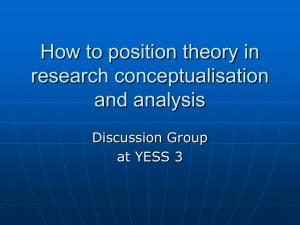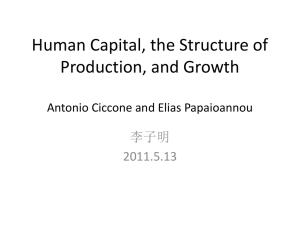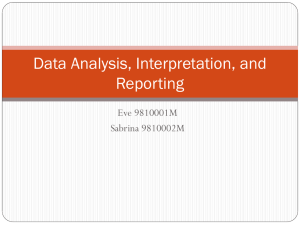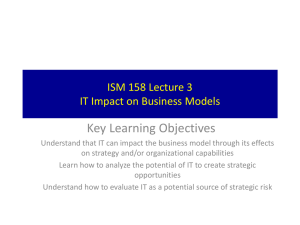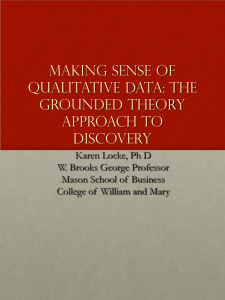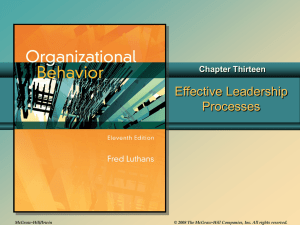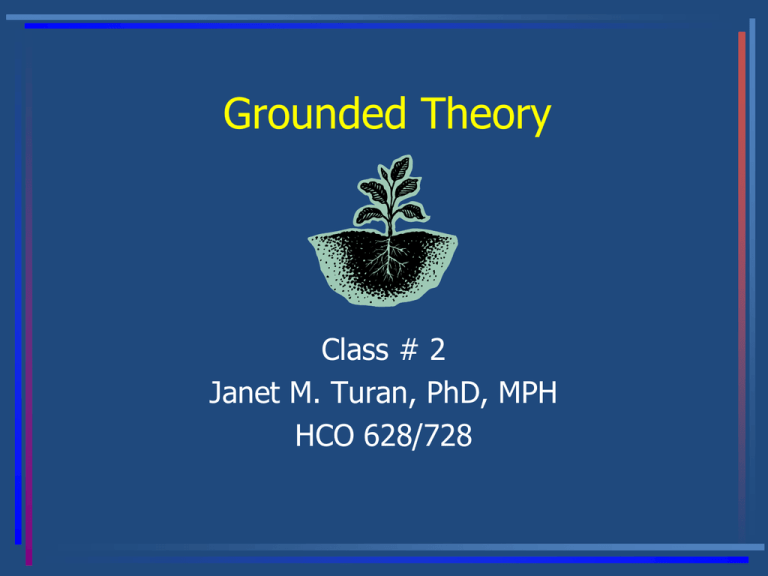
Grounded Theory
Class # 2
Janet M. Turan, PhD, MPH
HCO 628/728
Roots in Symbolic Interactionism
• Symbolic Interactionism:
– A social psychological approach focused on
the meaning of human actions
– reality is negotiated between people by
speech
– Reality is always changing
• Proponents of Symbolic Interactionism
– George Herbert Mead
– Herbert Blumer
Basics of Symbolic Interactionism
1. Human beings act towards things on
the basis of the meanings things
hold for them
2. Meanings of such things are derived
from interactions with other beings
3. Meanings are handled and modified
through interpretation
Methodology to fit those beliefs
• Although the empirical world is created
through the perceptions and interpretation of
humans, there is a reality
• The way to interpret the nature of a
constructed, interpretive empirical reality is
through
– Exploration
– Inspection
Exploration
• Form a close and comprehensive
acquaintance with a sphere of social life
• Develop and sharpen an inquiry so that
the inquiry remains grounded in the
empirical life under study
• The aim of exploratory study is to fill
out as comprehensive a picture as
possible of the area of study
Inspection
• Analyzing the objects/concepts
discovered by exploration so that
they make sense
• Finding links
• Understanding differences
• Seeing categories
Example: How do Burmese Farm Girls
Become Thai Sex Workers?
• Exploration: discovering the worlds of
Burmese Farm family life, trajectories of
individual girls’ stories, stories of procurers,
stories of “pimps” or madams
• Inspection: scrutiny and understanding of
the above in order to form relationships and
categories, how are individuals and
individuals different, how are they the same,
how do they compare ?
Grounded Theory
• Developed by Barney Glaser and Anselm
Strauss in l960s
– The Discovery of Grounded Theory, 1967
• Other proponents
–
–
–
–
Leonard Schatzman
Juliet Corbin
Kathy Charmaz
Adele Clark
• Used in social sciences, but particularly in the
applied social sciences
Grounded Theory
• Exploration and inspection of the empirical
world enables the researcher to construct a
theory grounded in the data
• Highly reflective method:
– Researchers fully aware of selves as
instruments for developing grounded
theory out of interaction with participants
and with the data
– In other words the “research act” is no
different than other interactions
Questions for Developing GT:
• What is going on here?
• Learn about a process/interaction/change from
the participants
• Examples:
– How does a career woman with a new baby re-enter the
work place?
– What are the perceptions of mothers who express breast
milk?
– What are the organizational processes which lead to
success of a flu vaccine campaign?
– What is the process of an elderly person accepting
death?
– How do Botswana female adolescents learn about
sexuality?
What is the “Stance” of the
researcher?
• Theoretical sensitivity
• Researcher seeks theory, constantly
works with data to tease concepts and
linkages
• Integration
• Synthesis
• Constant comparison
Reality
• Reality is constantly changing and being
negotiated
• Emphasis on detailed knowledge, constant
comparison and trajectory
• What is going on here? How is this example
different than the previous?
• Characteristics, conditions, causes,
antecedents and consequences of
events…what happens if?
• CONTINGENCY…CHANGE
• PROCESS
Data Collection for GT
• Data is particular, detailed, in-depth
• Constant probing, questioning,
comparison, reflecting
Analytical approach
• Look at a category—say “child care
dilemmas”
– Examine different strategies for dealing
with child care dilemmas (trajectories of
individuals)
– Linking similarities and differences
– What happens if…..
Fundamental Components of a Grounded
Theory Study (Sbaraini et al., 2011)
•
•
•
•
•
•
•
Openness
Analyzing immediately
Coding and comparing
Memo writing (often also diagrams)
Theoretical sampling
Theoretical saturation
Production of a substantive theory
Component
Openness
Description
Component
Description
Openness
• Inductive approach
• Goal of developing new theories from observations
• Emphasis of the study may evolve
Component
Description
Openness
• Induction
• Goal of developing new theories from observations
• Emphasis of the study may evolve
Analyzing
immediately
Component
Description
Openness
• Induction
• Goal of developing new theories from observations
• Emphasis of the study may evolve
Analyzing
immediately
• Do not wait until all the data are collected
• As soon as possible
• Continues in parallel with data collection
Component
Description
Openness
• Induction
• Goal of developing new theories from observations
• Emphasis of the study may evolve
Analyzing
immediately
• Do not wait until all the data are collected
• As soon as possible
• Continues in parallel with data collection
Coding and
comparing
Component
Description
Openness
• Induction
• Goal of developing new theories from observations
• Emphasis of the study may evolve
Analyzing
immediately
• Do not wait until all the data are collected
• As soon as possible
• Continues in parallel with data collection
Coding and
comparing
• Breaking data down into smaller components
• Labeling those components
• Comparisons to understand and explain variation
Component
Description
Openness
• Induction
• Goal of developing new theories from observations
• Emphasis of the study may evolve
Analyzing
immediately
• Do not wait until all the data are collected
• As soon as possible
• Continues in parallel with data collection
Coding and
comparing
• Breaking data down into smaller components
• Labeling those components
• Comparisons to understand and explain variation
Memo-writing
Component
Description
Openness
• Induction
• Goal of developing new theories from observations
• Emphasis of the study may evolve
Analyzing
immediately
• Do not wait until all the data are collected
• As soon as possible
• Continues in parallel with data collection
Coding and
comparing
• Breaking data down into smaller components
• Labeling those components
• Comparisons to understand and explain variation
Memo-writing
• About events, cases, categories, relationships
• Stimulate and record developing thinking
Component
Description
Openness
• Induction
• Goal of developing new theories from observations
• Emphasis of the study may evolve
Analyzing
immediately
• Do not wait until all the data are collected
• As soon as possible
• Continues in parallel with data collection
Coding and
comparing
• Breaking data down into smaller components
• Labeling those components
• Comparisons to understand and explain variation
Memo-writing
• About events, cases, categories, relationships
• Stimulate and record developing thinking
Theoretical
sampling
Component
Description
Openness
• Induction
• Goal of developing new theories from observations
• Emphasis of the study may evolve
Analyzing
immediately
• Do not wait until all the data are collected
• As soon as possible
• Continues in parallel with data collection
Coding and
comparing
• Breaking data down into smaller components
• Labeling those components
• Comparisons to understand and explain variation
Memo-writing
• About events, cases, categories, relationships
• Stimulate and record developing thinking
Theoretical
sampling
• Sampling on the basis of emerging concepts
• Aim to explore range and variation
• Selecting participants and modifying questions asked
Component
Description
Openness
• Induction
• Goal of developing new theories from observations
• Emphasis of the study may evolve
Analyzing
immediately
• Do not wait until all the data are collected
• As soon as possible
• Continues in parallel with data collection
Coding and
comparing
• Breaking data down into smaller components
• Labeling those components
• Comparisons to understand and explain variation
Memo-writing
• About events, cases, categories, relationships
• Stimulate and record developing thinking
Theoretical
sampling
• Sampling on the basis of emerging concepts
• Aim to explore range and variation
• Selecting participants and modifying questions asked
Theoretical
saturation
Component
Description
Openness
• Induction
• Goal of developing new theories from observations
• Emphasis of the study may evolve
Analyzing
immediately
• Do not wait until all the data are collected
• As soon as possible
• Continues in parallel with data collection
Coding and
comparing
• Breaking data down into smaller components
• Labeling those components
• Comparisons to understand and explain variation
Memo-writing
• About events, cases, categories, relationships
• Stimulate and record developing thinking
Theoretical
sampling
• Sampling on the basis of emerging concepts
• Aim to explore range and variation
• Selecting participants and modifying questions asked
Theoretical
saturation
• All of the concepts are well understood and supported
• No new properties, dimensions, relationships emerge
Component
Description
Openness
• Induction
• Goal of developing new theories from observations
• Emphasis of the study may evolve
Analyzing
immediately
• Do not wait until all the data are collected
• As soon as possible
• Continues in parallel with data collection
Coding and
comparing
• Breaking data down into smaller components
• Labeling those components
• Comparisons to understand and explain variation
Memo-writing
• About events, cases, categories, relationships
• Stimulate and record developing thinking
Theoretical
sampling
• Sampling on the basis of emerging concepts
• Aim to explore range and variation
• Selecting participants and modifying questions asked
Theoretical
saturation
• All of the concepts are well understood and supported
• No new properties, dimensions, relationships emerge
Production of a
theory
Component
Description
Openness
• Induction
• Goal of developing new theories from observations
• Emphasis of the study may evolve
Analyzing
immediately
• Do not wait until all the data are collected
• As soon as possible
• Continues in parallel with data collection
Coding and
comparing
• Breaking data down into smaller components
• Labeling those components
• Comparisons to understand and explain variation
Memo-writing
• About events, cases, categories, relationships
• Stimulate and record developing thinking
Theoretical
sampling
• Sampling on the basis of emerging concepts
• Aim to explore range and variation
• Selecting participants and modifying questions asked
Theoretical
saturation
• All of the concepts are well understood and supported
• No new properties, dimensions, relationships emerge
Production of a
theory
• Set of concepts related to one another cohesively
• Fallible, dependent on context, never final
Theory
• Small scale
• Focused
• Goal
– Creation of new theoretical concepts form
data
– Seeking core concepts
– Seeking to understand basic social
processes
What do GT Results look like?
• Goal is to develop a substantive theory
grounded in the data
– A set of concepts that are related to one another
in a cohesive way
• Single story line, core concepts, theory makes
sense of the data
• Identifies concepts, explores relationships
between concepts in stages or phases of the
process of the core category or variable
• Generally involves diagrams showing
relationships between concepts
Examples of Theories Developed
through GT Studies:
• A model of the process of adapting
preventive protocols into dental practice
(Sbaraini et al., 2011)
• Moving from frustration to questioning
traditional gender norms (Laisser et al.,
2011)
• ‘Expanding your mind’: the process of
constructing masculinities in young
Nicaraguan men participating in RH
training programs (Torres et al., 2012)
Moving from frustration to questioning traditional
gender norms (Laisser et al., 2011)
‘Expanding your mind’: the process of constructing
masculinities in young Nicaraguan men
participating in RH training programs (Torres et al.,
2012)
Adaptations of the GT Approach
• Some researchers do not follow all the
specific steps laid out by Glaser and Strauss,
but adopt several of the key principles,
commonly (See for example Ulin, pp. 31-32):
– Openness
– Emergent design
– Systematic coding
– Analyzing immediately
– Coming up with a theory/framework based
on the data
Process of GT
• What is happening here?
• First interviews very open, discovering
similarities and differences
• Theoretical sampling
• Examples of types/typologies
• Coding from first interview
• Coding/interviewing simultaneous
• Analysis informs and shapes subsequent
interviews
• Seeking variation, range of variability
• Saturation
Steps in a GT Project (see Sbaraini et
al., 2011)
A.
B.
C.
D.
E.
An open beginning and research questions
Ethics approval and ethical issues
Initial purposive sampling
Data analysis
Theoretical sampling, ongoing analysis, and
interviews
F. Mapping concepts, theoretical memos,
refining of concepts
How are GT and Ethnography
Different?
• Ethnography
– THICK description
– Relies most heavily on Participant Observation
– Long time in field
• GT
– Analytical
– Relies more on interviews
– Shorter time frame—looking at process and
trajectory during times of change
Goals of GT Studies in Public Health
• Not just descriptive of the problem
• Add insight on why and how a given
public health problem occurs
• Lead to UNDERSTANDING of how and
why public health interventions work or
do not work
How to Learn Grounded Theory
Methodology? Practice, Practice, Practice
•
•
•
•
•
•
Interviewing
Observation
Making Field Notes
Writing Memos
Coding
Writing, Writing, Writing


